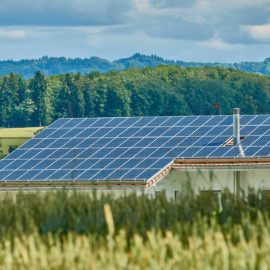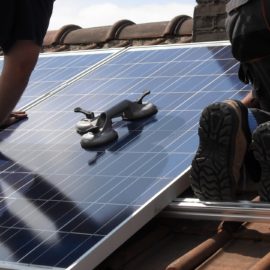
A massive, one of the largest in the country, solar farms is going up near St. Charles and questions are being asked.
Next to a vast expanse of pasture where cows graze outside Lake Charles, John Denison talks about a project sparking a collision of past, present and future. “We’re harvesting the energy of the sun,” said Denison, agriculture manager for Sweet Lake Land & Oil, whose presence in the region dates back decades. “Just like our rice and our cattle and our crawfish that we grow and our wildlife that we use for our hunting lodge. Those are all taking advantage of renewable resources. I look at it as just another farming activity.” Nearby residents, however, have deep concerns. And they are not ready to give up their fight anytime soon.
theadvocate.com
A pasture in the middle of not much, why is there a solar farm there? How big is massive?
A former rice farm in Calcasieu Parish may seem an unlikely place to look for a potential vision of the future. But the cow pasture may have something to show us. A plan to build a solar farm there the size of a small city – using roughly a million panels – has put a spotlight on how such projects can engender debate on a wide range of issues: the country’s environmental future, how best to regulate and tax it, and residents who feel trampled upon by industry — even when it’s “green.” The project appears to be the biggest of its kind proposed in the state; it would rank among the largest currently operating nationwide. Its sheer scale has provided a glimpse of what electricity generation in a post-fossil fuel world could look like. But it has also prompted a lawsuit from residents who say that, while they favor solar power, they have not received sufficient guarantees on issues ranging from health and safety to the effect on birds and other wildlife. “These are some concerns that they don’t even want to discuss with us,” said one resident, Monique Faulk, 43. The project is less than a mile from the home she shares with her husband, Michael Faulk, 44, and their two children. “And that bothers me. It makes me believe that there’s things that they’re hiding.” The company firmly disputes that and has sought to reassure residents, and one expert says he sees no health concerns with the project. But an overflow crowd of those in opposition packed a recent planning board meeting where the project was given the green light.
Solar panels, just sitting there absorbing the sunlight and they pollute? No known health or safety issues so they are hiding something when they are not noted? The fear of the unknown.
The project is being proposed by Aurora Solar, a subsidiary of Oregon-based Avangrid Renewables, itself part of the Spanish multinational firm Iberdrola. Aurora is leasing the land from Sweet Lake, a local company that traces its history back to the Chalkley family, which arrived from England in the 19th century. In a nod to that past, it is being called the Chalkley Solar Project. More recently, the company has been run by the family of Claude “Buddy” Leach, a former congressman perhaps best known for his run for governor in 2003. The company is leasing a total of 3,400 acres for the project, or more than five square miles. Solar panels will sit on more than two-thirds of that land. Once built, the project would generate between 300 and 400 megawatts of electricity, roughly enough to power 30,000 homes in Louisiana, according to industry estimates. As a comparison, Entergy’s recently opened Lake Charles Power Station has a 994-megawatt capacity. “The biggest (in the state) thing doesn’t make any difference to me,” said the company’s project developer, Andrew Makee. “We’re trying to meet demand and we feel like a project of this size gives us good economies of scale to produce a very competitive price. And that’s why you’re seeing projects a little bit on the larger size.”
5 acres for solar and generates 400 megawatts. Power station generates 994 megawatts. First thing I ask is how much land is the power station on? Compare land size. I knkow it takes more for solar but can we afford more power stations emitting pollution. Trade offs.
Aurora’s aim is to sell electricity to companies like Entergy, though it does not yet have a contract in place. That means construction could be cancelled outright if the developers do not line up a buyer, said Makee. It also means the solar farm will not necessarily provide any special backup power when electricity goes down after hurricanes. The electricity can only be distributed if the farm’s customers – meaning Entergy or another utility – are in position to take it. The company will be seeking tax breaks through the state’s Industrial Tax Exemption Program or a separate agreement in lieu of taxes. Aurora estimates that, if the breaks it’s seeking are approved, it would pay between $30 million and $40 million in property taxes over 30 years. It plans to invest up to $325 million and create 300 to 500 temporary construction jobs. There would only be three or four full-time long-term employees, which is common for solar farms. Vegetation will be planted and maintained around the perimeter of the project to keep residents from seeing it.
Why Calcasieu? What is the reason for this development? What can we expect?
Makee says part of the reason Aurora chose the Calcasieu site is because it is lower-value farmland. Some farmers who lease land in the state have expressed concerns over solar projects driving up rents. What lies behind such proposals is a growing demand for renewable energy, which currently accounts for only around 3.3% of utility-scale electricity generation in Louisiana, compared to a nationwide average of 18.5%. Much of it is driven by utilities’ desire to incorporate more renewables into their energy mix, part of larger efforts to limit climate change by moving away from fossil fuel-fired plants that emit greenhouse gases. As one example, Entergy is aiming to have net-zero carbon emissions by 2050. Profit motive also plays a major role since renewable power can in certain cases be produced at cheaper rates than traditional sources, said Terrence Chambers, who directs the Energy Efficiency and Sustainable Energy Center at the University of Louisiana at Lafayette. “It’s the economics that is driving the massive increase in the amount of renewables being added to the grid,” Chambers said.
Solar power has been on the drawing boards for years but real progress has only been in the last few years.
He said 2019 was the first year more renewable energy than traditionally generated power was added to the U.S. supply. The country is on pace this year to have two-thirds of new electrical generation capacity come from renewables, said Chambers. Some states have set standards for how much renewable energy utilities must incorporate into their mix, but Louisiana has not, he said. Beyond solar, there has been talk of developing wind energy in the Gulf of Mexico. Chambers also believes the state would be wise to become involved in the manufacturing portion of the industry, which could provide a new source of jobs.
In these days of skepticism for many new ideas false narratives have hit the solar industry as well.
Chambers has produced a study seeking to dispel myths related to health and other risks linked to solar farms. He says that from what he’s seen on the Calcasieu project, residents should have nothing to fear. He called such solar farms “the most passive development you could possibly have other than agriculture.” The company says it is conducting environmental surveys required by federal and state permitting agencies. It says it carried out a more limited “desktop environmental analysis” that turned up no issues. Residents have sought to press a number of points they feel are unresolved. One involves Louisiana lacking a central regulating authority for solar development, while the other has to do with the wind speed the panels will be able to withstand, a particularly resonant issue in a region that endured Hurricane Laura’s 150 mph winds last year. On regulation, the Legislature has passed a law tasking the state Department of Natural Resources to come up with proposed guidelines, and it is in the process of doing so, said spokesman Patrick Courreges. Currently, such developments are subject to piecemeal regulation by various entities.
Living in Louisiana and especially in the Lake Charles area, the question of sustainability in wind conditions is a very real question.
Regarding wind speed, residents say they were provided with conflicting information, with the company first indicating the project would be equipped to handle 149 mph winds. Makee has since clarified that the project would withstand 123 mph winds, in compliance with the area’s risk rating, but that Aurora is working with its suppliers to determine whether that can be increased. Regardless, the residents’ lawyer, Maurice Tynes, argues that the way the planning board approved the project — in a 6-4 vote granting an exception to the area’s agricultural zoning — was illegal. He says solar farms are not included in the list of exceptions. “You don’t have the right to grant this exception — that’s the end of it,” he told the board. “And if you do grant it, we’ll see what the judges say all the way to the Supreme Court.” Calcasieu Parish Planning Director Wes Crain said he could not discuss the project because of the pending lawsuit.
Solar is not the only change coming to the area. As more people want homes, that will also disrupt the farming areas.
While the land surrounding the project is largely agricultural, change is occurring slightly further away with new, suburban-style subdivisions. The large-scale Morganfield development, in particular, has been seeking to draw families with its pitch that “we cherish smaller, tight-knit towns of the past where you can safely walk the streets.” But Michael Faulk is no newcomer. He spent much of his youth in the house next door to the one he and his wife later built. They plan to continue raising their two children there. The dispute in many ways mirrors those around innumerable other developments over decades, with residents concerned about how a new project might affect them. But in this case, there are so many issues at play it can be dizzying. Residents feel it should be located in a more remote location. “You’re talking about a million solar panels. And you’re talking about 2,400 acres that they’re putting it on,” Faulk said. “So you’re talking about just a massive project.”
Solar power is new to this state. Our “Oil State” description is falling. Would the farmers complain as much if what is in St. James Parish came to them? Would the familiar, although more polluting, be more acceptable? What it does show is that solar is not much use if it is not integrated into the energy network.



